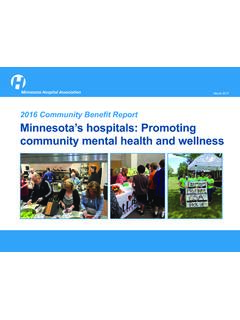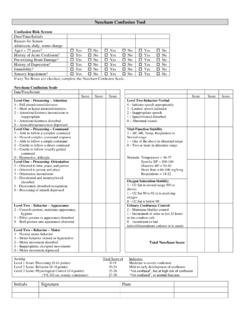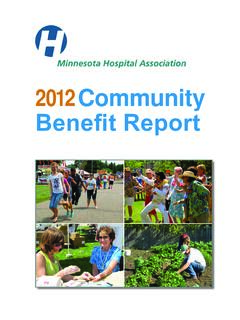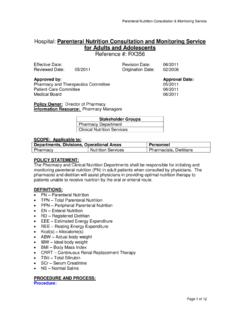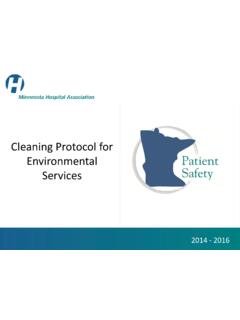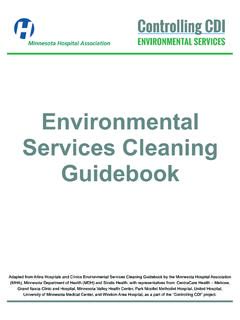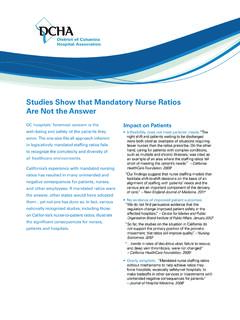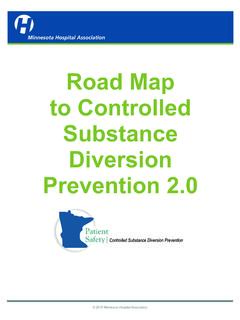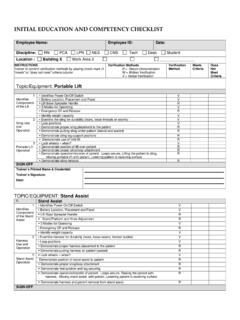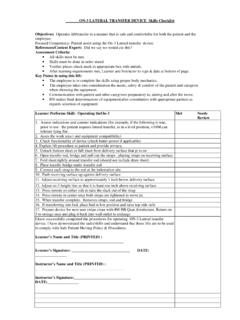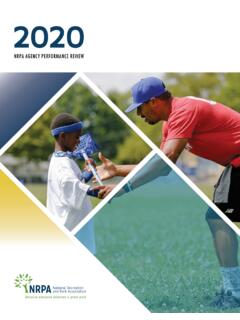Transcription of Preoperative Recommendations / Guidelines - MHA
1 Preoperative Recommendations / Guidelines Fairview Health Services 6/2009. The following Recommendations are the product of a multidisciplinary group* charged with coming up with standardized Recommendations to guide the Preoperative evaluation of patients before surgery. These Recommendations are made to help establish systems to aid in appropriate preparation of patients for surgery. They may be used to set up EHR reminders or clinic and hospital work flows. However, clinical judgment supersedes these Recommendations ( No mention is made, but clearly severe COPD may call for ABGs prior to surgery, or sleep study if severe sleep apnea suspected but not diagnosed, or BB may not improve risk if relatively low risk surgery and only one lower level risk factor such as HTN). *The Development Group: Michael Dummer, MD (Lakes, IM) Joel Arney, MD (Ridges, Anesthesiology). Danielle Doro, MD (Crosstown Clinic, IM) Joe Arcuri, MD (UMP, IM).
2 Angela Fitch, MD (Eagan Clinic, IM) Mike Aylward, MD (UMP, IM/Peds). Mark Nomura, MD (Southdale, Sara Frankwick, MD (FP, Maple Grove). Anesthesiology) Beverly Christie, DNP, RN (Director of Barbara Gold, MD (UMMC, Anesthesiology) Clinical Knowledge). Kent Svee, MD (Lakes, IM) Milena Ninkovic, MD (IT Knowledge Barry Bershow, MD (Ambulatory QIC) Engineer). David Kaisaki, MD (Northeast Clinic, IM) Jackson Thatcher, MD (cardiology, Park James Bergstrom, MD (CPMC, IM) Nicollett). Laura Stoiber, MD (Lakes, surgery) David Laxson, MD (cardiology, MN Heart). ~ Reviewed by the System Clinical Pharmacy Committee I. CARDIOVASCULAR RISK MODIFICATION. A. Preoperative Beta Blockers Recommendations * (Thatcher, 2006, Fleisher, 2007, ICSI, 2008). 1 Patients on chronic beta-blocker therapy should continue taking their beta-blocker medication up to and including the day of surgery. 2 Beta-Blockers are recommended to be started for patients who have DM, HTN, IVD, (cerebrovascular disease, CAD, PVD) AF, CHF for intermediate and high risk surgeries.
3 May be indicated for other patients with high risk of cardiac disease ( combination of age, smoker, high cholesterol, family history). 3 Start Beta-blockers as soon as possible as outpatient and titrate dose to resting target pulse 55- 65. If time does not allow additional follow-up or titration, start Beta-blocker and communicate the initiation to anesthesia/surgery. It should not be necessary to cancel or postpone surgery solely for the institution of Beta-Blocker. For patients starting a beta-blocker prior to surgery we recommend using Metoprolol succinate XR 100mg daily. (Consider the dose if patient is small, frail, elderly or resting heart rate of <. 65 or systolic BP of < 110). Instruct patient to take pulse or have them come in for nurse pulse check and advise to increase dose if pulse >70. Continue the Beta-Blocker for 2-4 weeks after surgery. 4 If heart rate is not controlled with current dose, maximizing heart rate control should be attempted if on it for the above indications.
4 5 Considerations: Start at the above recommended dose and instruct patient to take pulse or have them come in for nurse pulse check and advise to increase dose if pulse >70. Beverly Christie, DNP, RN 1. 6 Potential contraindications or not recommended in patients who: Need emergent surgery Have an allergy to beta-blockers Have bradycardia (HR < 50). Advanced heart block (greater than one first-degree AV block) unless treated by pacemaker Severe bronchospasms/COPD/asthma/reactive airway disease For patients undergoing only Low Risk Procedures: see grid below Cardiac Risk* Stratification for Noncardiac Surgical Procedures High (Reported cardiac risk Intermediate (Reported cardiac risk Low (Reported cardiac risk generally less often greater than 5%) generally less than 5%) than 1%). Emergent major operations, Carotid endarterectomy Endoscopic procedures particularly in the elderly Head and neck surgery Superficial procedure Aortic and other major vascular Intraperitoneal and intrathoracic Cataract surgery, most surgery surgery Ophthalmologic procedures Peripheral vascular surgery Anticipated prolonged surgical Orthopedic surgery Breast biopsy procedures associated with large Prostate surgery Removal of minor skin or fluid shifts and/or blood loss subcutaneous lesion Myringotomy tubes Hysteroscopy Cystoscopy Fiberoptic bronchoscopy *Combined incidence of cardiac death and nonfatal myocardial 7 Beta-Blockade and Heart Failure: Two beta-blockers have demonstrated efficacy in heart failure patients: Metoprolol (MERIT-HF).
5 And Carvedilol (COPERNICUS). (Bisoprolol has also shown benefit but it not widely available in the United States). Patients with systolic dysfunction (EF < 40%) should be on Metoprolol succinate (Toprol) or Carvedilol (Coreg) preoperatively, provided they do not have a contraindication. Atenolol is a suitable alternative for patients with diastolic heart failure (EF> 40%). Recommended dose would be Metoprolol succinate 100mg daily *The workgroup recognized that there are many divergent Recommendations regarding the best inclusion protocol for beta- blocker therapy, but that we needed to come to a definitive recommendation in order to facilitate EHR reminders, work flows and standards to support the use of Heart Rate control for risk reduction across Fairview sites.. Beverly Christie, DNP, RN 2. B. Active Cardiac Conditions (see algorythm below) Cardiology Consultation Recommended: (Thatcher, 2005, Fleisher, 2007, ICSI, 2008).
6 1 Unstable coronary disease: Unstable or severe angina, Recent MI (I 1 month). 2 Decompensated HF: NYHA class IV, worsening or new onset HF. 3 Certain arrhythmias: High-grade AV block, Mobitz II, 3rd degree AV block, Symptomatic ventricular arrhythmias, SVT or A-fib with uncontrolled rate, symptomatic bradycardia, new V-tach 4 Severe valvular disease: Severe AS (mean pressure gradient >40mm, valve area< , or symptomatic) Symptomatic mitral stenosis (increasing SOB, presymcope or HF). C. Stress Testing Guideline: (Thatcher, 2006, Fleisher, 2007, ICSI, 2008). 1 Stress testing may be considered if: clinical evaluation suggests need for stress testing independent of impending surgery ( undiagnosed chest pain, long history of poorly controlled DM, or in some instances monitoring of patients after recent revascularization). vascular or high risk surgery plus 3 or more risk factors, which include: DM.
7 CHF. IVD (CAD, PVD, Thrombotic Cerebrovascular disease). Cr>2. Poor functional capacity (<4 METs). 2 Current evidence does not support a strategy of routine revascularization in stable patints as a strategy to reduce morbidity/mortality (McFalls, et al., 2004, Poldermans, et al., 2006). Stress testing is therefore primarily recommended for indications that would be valid independent of the proposed surgery. Stress testing may however be indicated, especially for high risk but elective surgeries ( , major spine surgery), to assist in the determination of risks vs. benefits, as well as determining perioperative monitoring strategies. 3 Functional status < 4 METs should be seen as a primary risk factor (see table 3 below). If a patient has an impending high risk surgery with prolonged procedure or significant fluid shifts, this can be seen as a significant aerobic challenge.
8 Stress testing can help determine the patient's ability to tolerate that kind of stress. If the decision is made to proceed to Preoperative stress testing, consensus of the committee recommended stress imaging (Stress echo, dobutamine stress echo, stress cardiolyte, or adenosine cardiolyte ) to improve sensitivity and specificity. Table 3. Estimated Energy Requirements for Various Activities Can you . Can you . Climb a flight of stairs or walk up a hill? 1 MET Take care of yourself? 4 METs Walk on level ground at 4 mps ( kph)? Eat, dress, or use the toilet? Run a short distance? Walk indoors around the house? Do heavy work around the house like Walk a block or 2 on level ground at 2 to scrubbing floors or lifting or moving heavy 3 mph ( to kph)? furniture? Participate in moderate recreational Do light work around the house like activities like golf, bowling, dancing, doubles 4 METs dusting or washing dishes?
9 Tennis, or throwing a baseball or football? Participate in strenuous sports like Greater than 10 METs swimming, singles tennis, football, basketball, or skiing? Kph indicates kilometers per hour: MET, metabolic equivalent and mph, miles per hour. *Modified from Hlatky et al. (10) copyright 1989, with permission from Elsevier, and adapted from Fletcher, et al. (11). Beverly Christie, DNP, RN 3. 1. ACC/AHA perioperative Guidelines : ACC /AHA Perioperative Guidelines Perioperative surveillance and postoperative risk Need for emergency Yes Operating room Step 1 stratification and risk factor noncardiac surgery? (Class I, LOE C). management No Evaluate and treat per Consider Active Cardac Yes Step 2 ACC/AHA operating room conditions* (Class I, LOE B). Guidelines No Proceed with Low risk surgery Yes Step 3 planned (Class I, LOE B). surgery No Good functional capacity Step 4 (MET level greater than or Yes Proceed with equal to 4) without (Class I, LOE B) planned surgery symptoms Step 5 No or unknown 3 or more clinical 1 or 2 clinical risk risk factors factors No clinical risk factors Vascular Intermediate surgery risk surgery Vascular Intermediate Class I, surgery risk LOE B.
10 Class IIa surgery LOE B. Proceed with Consider testing if it planned surgery will Proceed with planned surgery with HR control (Class ll a, LOE B). change management or consider noninvasive testing (Class ll b, LOE B) if it will change management. Risk factors include history of CAD, CHF, IVD, DM, Renal insufficiency. Figure 1. Cardiac evaluation and care algorithm for noncardiac surgery based on active clinical conditions, known cardiovascular disease, or cardiac risk factors for patients 50 yrs of age or greater. Clinical risk factors include ischemic heart disease, compensated or prior heart failure, diabetes mellitus, renal insufficiency, and cerebrovascular disease. Consider perioperative beta blockade for populations in which this has been shown to reduce cardiac morbidity/mortality. ACC/AHA indicates American College of Cardiology/American Heart Association; HR, heart rate; LOE, level of evidence; and MET, metabolic equivalent.
